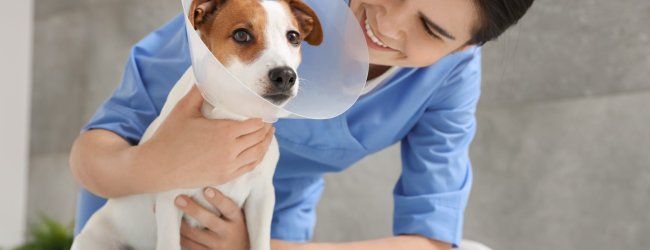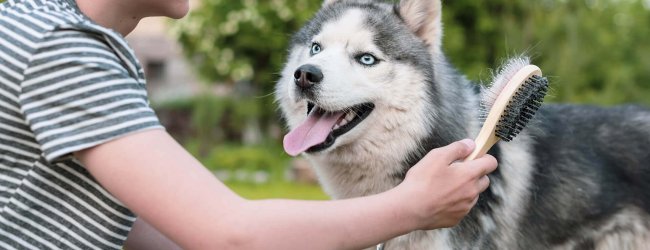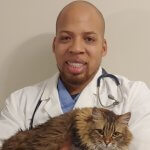 Approved by Dr. Dwight Alleyne, DVM
Approved by Dr. Dwight Alleyne, DVM How To Tell If My Cat Is Sick? The Main Signs Of Illness In Cats
Cats are pretty notorious for hiding signs of sickness. So how can you tell if your cat is sick in the first place? In these cases, it helps to watch out for changes in their behavior.
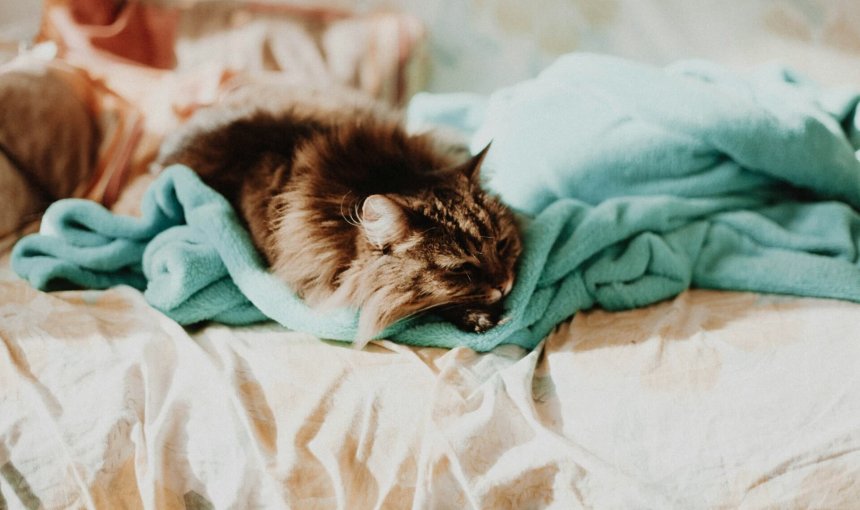
As a loving cat parent, you’ve likely observed a change in your cat’s behavior and found yourself wondering: Is my cat sick? Or how do I know if my cat is sick? In this post, we’ll explore the most common signs of illness in cats and offer tips on how to catch them early. Plus, we’ll show you how tracking your cat’s activity with a smart cat collar can help you spot potential health issues before they get worse.
Key Takeaways
Look for big shifts in how your cat acts.
A sick cat might suddenly start sleeping too much, hiding all the time, or acting grumpy and aggressive. This is a clear sign that you should pay closer attention.
Watch their eating and drinking habits.
If your cat stops eating, drinks a lot more water than usual, or is suddenly gaining or losing weight, these are serious clues that you need to tell your vet about.
Check their litter box and breathing.
Any straining or major changes in how often they pee or poop can point to a health problem. You should also listen for coughing, sneezing, or if they seem to have a hard time breathing.
You can use a Tractive smart cat collar to constantly monitor your cat’s activity and sleep patterns, which can help you catch these unusual health changes earlier and get help sooner.

Find out where your cat spends their time.
Read more- Key Takeaways
- How do cats act when they are sick?
- How to tell if my cat is sick?
- 1) Change in activity and sleep levels
- 2) Changes in eating or drinking habits
- 3) Lethargy and unexplained fatigue
- 4) Changes in litter box habits
- 5) Unexplained weight loss or gain
- 6) Excessive grooming or unkempt coat
- 7) Coughing, sneezing, or difficulty breathing
- 8) Behavioral changes
- 9) Fever and shivering
- 10) Changes in eyes, nose, or mouth
- How is my indoor cat sick?
- Will cats purr if they are sick?
- When to see a vet
- Where a Tractive smart cat collar can help
How do cats act when they are sick?
Cats are really good at hiding it when they don’t feel well.This means that as a cat parent, you have to be extra vigilant for tiny changes in their behavior. One of the biggest clues is a change in how much they interact with you. A sick cat might suddenly hide all the time, not want to play, or stop greeting you at the door. On the flip side, some cats that are usually independent might suddenly become super clingy and needy. Either way, a big change in their usual social habits is a red flag.
You should also pay close attention to their eating and drinking habits. Is your cat suddenly refusing their favorite food? Are they eating much less than normal? Are they going to the water bowl more or less often? If they suddenly stop using their litter box, that’s also a big sign that something is wrong.
Finally, watch how they move. Are they moving slowly or seem stiff? Are they having trouble jumping up to their favorite spot? Are they sleeping way more than usual? If you notice any of these signs, it’s a good idea to call your vet and tell them what you’ve noticed.
How to tell if my cat is sick?
1) Change in activity and sleep levels
Cats tend to be creatures of routine – so don’t overlook any sudden changes in how much they sleep or how active they are. If your normally energetic cat suddenly becomes more sedentary, or if your cat who loves to nap seems to be sleeping excessively, it could signal illness. On the other hand, if your cat becomes hyperactive or restless at night, it might be due to discomfort or stress.
Using a smart cat collar can help you keep an eye on your cat’s activity levels. Your Tractive device constantly monitors your cat’s activity and sleep. If it detects a change, it’ll send you a Health Alert. You can share these insights with your vet, so it’s easier to diagnose potential health issues early.
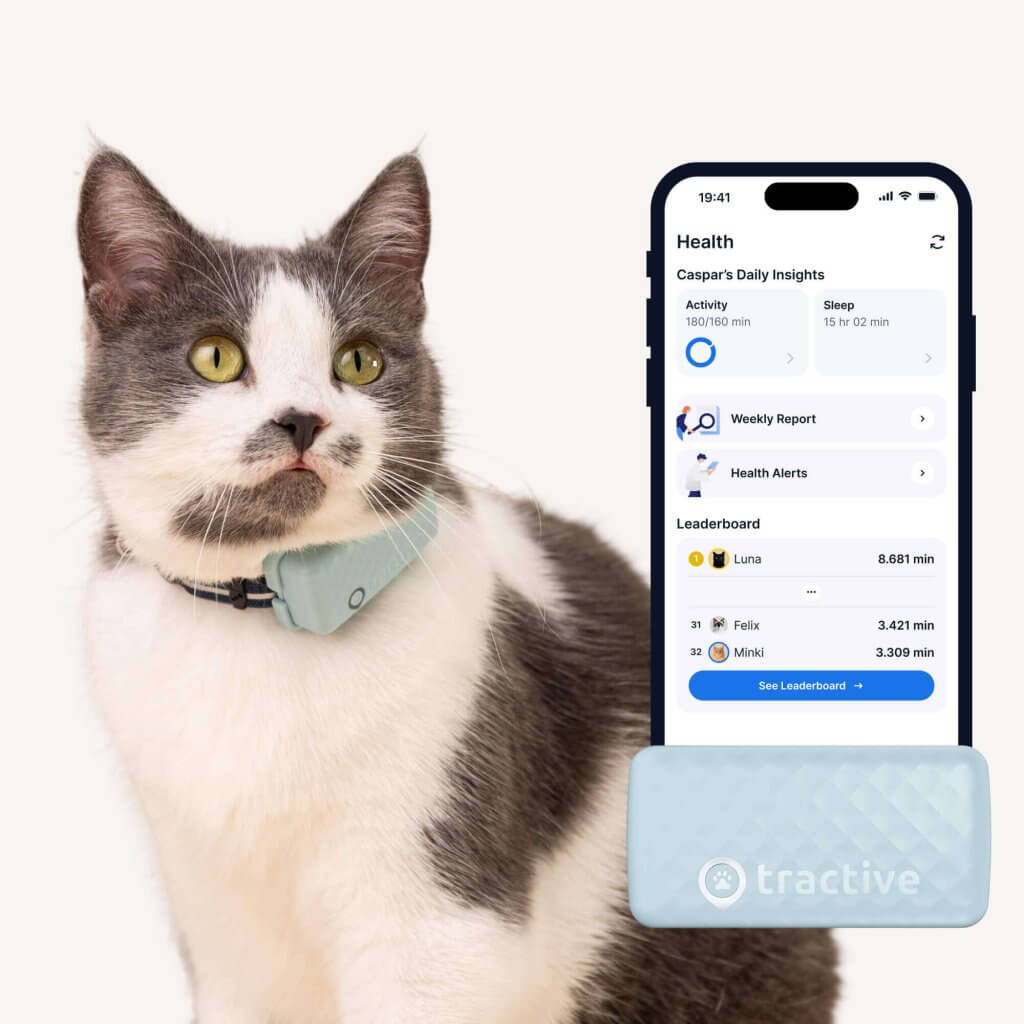
Get health alerts for your cat
Our cats can’t always tell us if something’s wrong. But if their tracker detects unusual changes in their routine, you’ll get an alert, helping you catch potential issues early.
Read More: 8 Pet Parents Who Keep Their Cats Healthy With Tractive
2) Changes in eating or drinking habits
A sudden change in your cat’s eating or drinking habits can be a red flag. If your cat suddenly stops eating or won’t drink water, it may be a sign of an underlying issue such as dental problems, gastrointestinal issues, or even kidney disease. On the other hand, if your cat suddenly starts drinking a lot of water (polydipsia) or has a sudden increase in hunger (polyphagia), it could indicate diabetes or hyperthyroidism.
3) Lethargy and unexplained fatigue
Cats are naturally curious and playful creatures. If your cat is suddenly lethargic, sleeps more than usual, or seems disinterested in playing or exploring, it could be a sign of illness. This could point to a range of issues, from a simple cold to more serious conditions like anemia or heart disease.
What to look for:
- Excessive sleeping or hiding
- Lack of interest in usual activities or toys
- Difficulty moving or walking
4) Changes in litter box habits
Paying attention to your cat’s litter box habits can give you important insights into their health. Changes in urination or defecation, such as increased or decreased frequency, difficulty urinating, or blood in the urine, are all signs that your cat may be unwell. These issues could indicate a urinary tract infection (UTI), kidney problems, or even feline lower urinary tract disease (FLUTD).
What to look for:
- More frequent or less frequent urination
- Straining to urinate or defecate
- Blood in the urine or stool
- Diarrhea or constipation
5) Unexplained weight loss or gain
If your cat is losing weight without a change in diet, or gaining weight without overeating, it’s important to get them checked by a veterinarian. Weight loss can indicate issues such as hyperthyroidism, diabetes, or even cancer, while weight gain may point to hormonal imbalances or problems with their metabolism.
What to look for:
- Noticeable weight loss or gain
- Visible changes in body shape
- Increased or decreased appetite without a clear cause
6) Excessive grooming or unkempt coat
Cats are known for their grooming habits, but if you notice that your cat is grooming excessively, it could be a sign of stress, allergies, or skin problems like fleas or dermatitis. On the other hand, if your cat has stopped grooming altogether and their coat appears dull or matted, this may indicate pain, arthritis, or other health concerns.
What to look for:
- Over-grooming or licking certain areas
- Lack of grooming and a dull, matted coat
- Bald spots or skin irritation
7) Coughing, sneezing, or difficulty breathing
Respiratory issues in cats are serious and should be addressed promptly. Coughing, wheezing, or labored breathing could be symptoms of a respiratory infection, asthma, or even heart disease. If your cat is having difficulty breathing or you notice rapid breathing, it is essential to seek immediate veterinary attention.
What to look for:
- Frequent coughing or sneezing
- Labored breathing or wheezing
- Nasal discharge or watery eyes
8) Behavioral changes
Cats are creatures of habit, and any sudden behavioral changes should not be ignored. If your cat is hiding more frequently, becomes aggressive, or shows signs of anxiety or fear, it may be due to pain, stress, or illness. Changes in behavior are often the first sign of discomfort, and identifying the cause early can help prevent more serious complications.
What to look for:
- Sudden aggression or irritability
- Hiding more than usual or avoiding interaction
- Increased anxiety or stress-related behaviors (e.g., excessive scratching)
9) Fever and shivering
If your cat is shivering or has a fever, it’s usually a sign of an infection or inflammation. A fever can be caused by anything from a simple cold to a more serious condition like an abscess, kidney disease, or cancer. If you suspect your cat has a fever, contact your veterinarian for advice.
What to look for:
- Shivering or trembling
- Warm or hot ears
- Decreased activity levels
10) Changes in eyes, nose, or mouth
Changes in your cat’s eyes, nose, or mouth can be indicative of health issues. Watery eyes, squinting, or redness can suggest a respiratory infection, while drooling, bad breath, or difficulty eating could point to dental disease or oral problems.
What to look for:
- Red, watery, or squinting eyes
- Excessive drooling or bad breath
- Difficulty eating or swallowing
How is my indoor cat sick?
- Germs you bring home.
When you come back from work, the grocery store, or even just a walk, you can carry tiny germs on your shoes, clothes, or hands. If your cat brushes against your pants or walks where your shoes were, those germs could make them sick. - Respiratory infections.
If you or someone else in the house is sick with a cold, your cat can sometimes pick up a version of it. It’s not common, but it can happen. - Hereditary or internal problems.
Cats can develop health issues like kidney problems, diabetes, or even different kinds of cancer, no matter where they live. These are usually related to their genetics, their age, or how their body is working on the inside. - Toxic substances.
A whole bunch of common household items can be toxic if your cat decides to chew on them. Common house plants (like lilies) or even licking up a small amount of household cleaner can make your cat extremely sick, so it’s important to keep those things out of reach.
Even though your cat is safe inside, regular vet visits are super important to make sure they are healthy on the inside, too.
Will cats purr if they are sick?
Yes – and it’s actually a way for them to comfort and soothe themselves when they are feeling stressed, anxious, or even when they are hurt or sick. Think of it like a human humming to themselves when they are nervous or trying to make themselves feel better. When your cat is uncomfortable, sick, or stressed (like on the way to the vet), the purr seems to calm their nerves.
If your cat is purring, but also hiding, not eating, or acting really tired, you shouldn’t ignore the other signs of sickness just because you hear that comforting rumble. Always look at the whole picture – the purr might be a sign that they are trying to feel better, not that they are better.
When to see a vet
If you notice any of the signs mentioned above, it’s important to consult with a vet. Early diagnosis can make all the difference in your cat’s health and wellbeing. Your vet will conduct a thorough examination, and may recommend tests like blood work, urine analysis, or X-rays to determine the cause of your cat’s symptoms.
Where a Tractive smart cat collar can help
A sick cat is likely to hide when struggling with pain or discomfort – so you might miss the signs. That’s where technology can lend a hand. Here’s how your trusty Tractive device can help you spot potential health issues early.
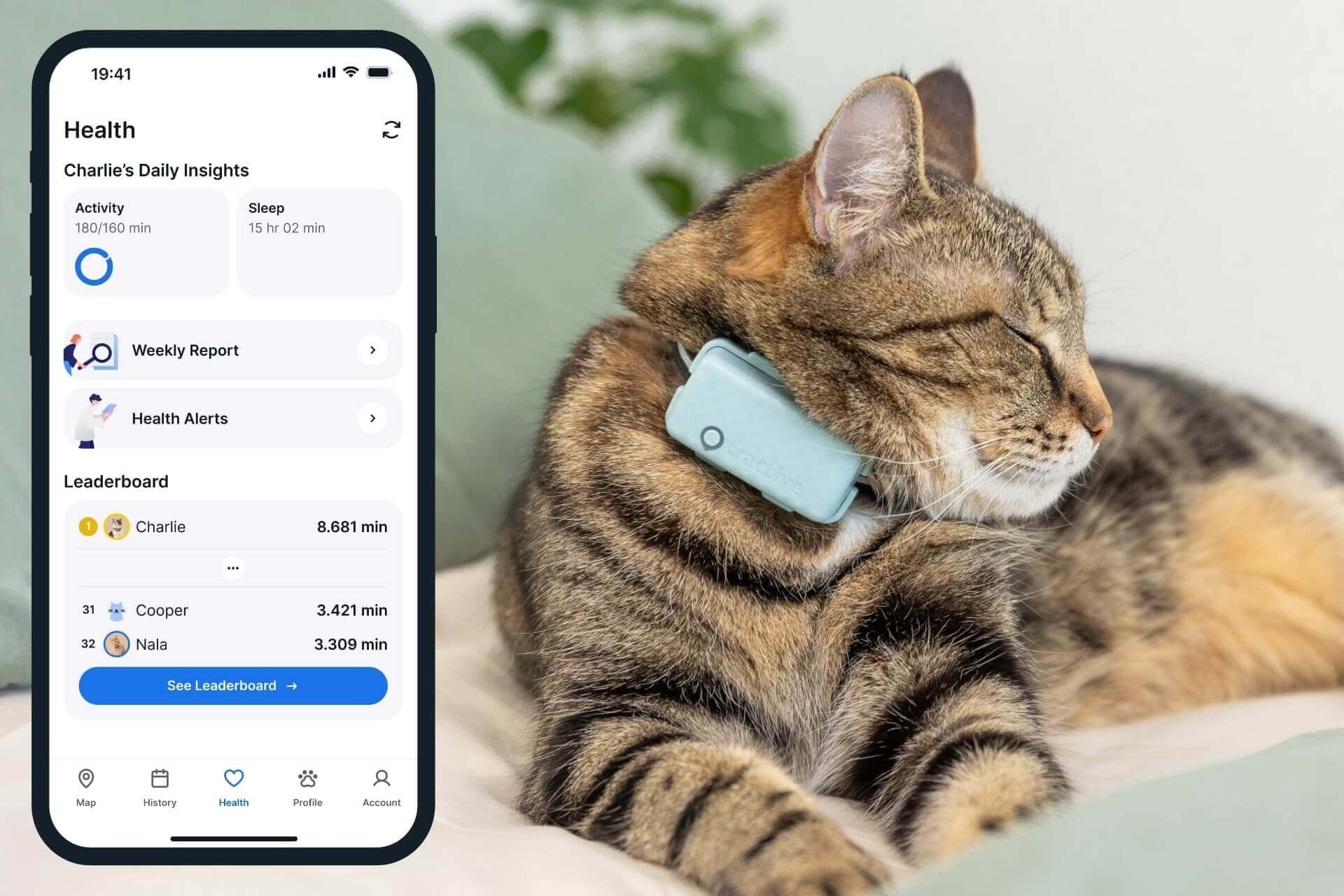
Activity Tracking
Your cat is a creature of habit. They usually have a normal level of playing, running, or exploring. The collar tracks their daily activity. If your cat suddenly becomes way less active for a few weeks or months – not wanting to play or moving around less – that’s a big red flag. A drop in activity can be an early sign of many issues, like pain, arthritis, or even an infection. The tracker gives you the hard data to show your vet, which can help them diagnose your cat’s illness that much better.
Sleep Tracking
Cats sleep a lot – up to 16 hours a day or more! Your Tractive collar tracks the quality and amount of their sleep, both day and night. If you notice your cat is sleeping much more than usual, or if they are waking up constantly during the night when they are normally sound asleep, the tracker will show you. Big changes in sleep patterns can point to problems like illness, stress, or discomfort.
Health Alerts
With time, Tractive’s system learns what is normal for your cat. If their activity or sleep suddenly changes and stays that way, the app sends you a Health Alert. This alert tells you something’s off, giving you a chance to call your vet and get your furry friend checked out much earlier than you might have otherwise.

“Great little tracker, perfect size and weight for cats.
Tracks activity and sleep habits, making it easier to spot issues and discuss activity levels with her vet.
– Clayton Ward, US (Source: Trustpilot)
Remember, you know your cat best – if something seems off, don’t hesitate to reach out to your vet for advice!
Your furry friend’s health and wellbeing means as much as to us as it does to you. So we’ve made it a priority to only share medically-relevant content on our blog.
This post was checked, double-checked, and medically verified by Georgia-based vet, Dr. Dwight Alleyne.

Originally from Long Island, New York, Dr. Alleyne began his career at a no-kill animal shelter before becoming a licensed veterinary technician. He graduated from Cornell University Veterinary College in 2006 and completed an internship at Purdue University. Now practicing in Georgia, Dr. Alleyne specializes in soft tissue surgery and ultrasounds. He also writes pet health articles on his website, “The Animal Doctor Blog” (www.anmldrblog.com).
